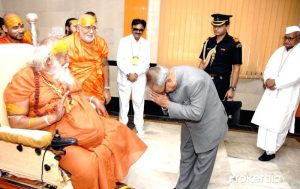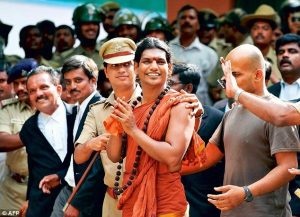These godmen are clever self-styled crooks and thieves: A Jodhpur court convicted self-styled godman Asaram on Wednesday, 25th April 2018 and sentenced him to life imprisonment for the rape of a teenage girl at his ashram in Manai village near Jodhpur in 2013. His son Narayan Sai is currently in jail for sexually assaulting a woman at one of Asaram’s ashrams between 2002 and 2005. Sai has also been accused of sexually abusing eight other girls, some of whom were his followers. Gurmeet Ram Rahim is another self-styled godman who had his followers dancing to his tunes, quite literally. Dera Sacha Sauda Chief Gurmeet Ram Rahim Singh not only delivered religious sermons but also acted in films and gave performances on stage; he is also behind the bars for rapes, murders, money laundering.
A Chennai based godman Nithyananda’s face was plastered all over television screens when video clippings of him cropped up showing him supposedly engaging in sexual acts with a Tamil actress in March 2010. He had claimed then that he was only practising the shavasana, a yoga posture, at the time. He also claimed to be impotent and, therefore, incapable of intercourse. Shiv Murat Dwivedi alias Ichchadhari Sant Swami Bhimanand Ji Maharaj – Chitrakoot Wale allegedly amassed wealth to the tune of crores by allegedly running a sex racket. He is also accused of running a website for flesh trade. On February 25, 2010, he was held with two air hostesses on account of running prostitution ring for almost a decade in the national capital. On March 9 of the same year, MCOCA charges for flesh trade were slapped on him. He was seen in a video doing the ‘naagin dance’, seemingly under the influence of alcohol.
Self-styled godman Santosh Madhavan alias Swami Amrit Chaitanya was arrested in 2008 on charges of rape of minor girls as well as cheating an NRI woman. He was convicted by a Kerala court of misusing money from his followers as well as the rape of four minors. Premkumar alias Ravi alias Swami Premananda of Premananda Ashram, located in Tiruchirapally, Tamil Nadu, was accused of raping as many as 13 inmates and molesting two followers. He was also accused of killing Ravi, an engineer, in the ashram premises in 1994. He was sentenced to life by the Supreme Court in 2005. He passed away in February 2011 owing to ill health. He was also accused of rape by one of his former follower. According to reports, the police had found drugs, condoms and other contrabands when his ashrams were raided.
These and many more babas and matas have made divinity their business and preoccupation. Right from the Maharaj libel case (1862) through the manoeuvrings of Chandraswami and Dhirendra Brahmachari, to the present-day saga of Dera Sacha Sauda and Asaram Bapu, the list is eternal. Their ashrams are addas (den) for crime: sex, drug trafficking, human trafficking, money laundering, politicking and all sorts of anarchy. The godmen are famous for multiple heinous and appalling criminal cases.
Modus operandi: The fact is the godmen have undaunted followers who are in irrational awe of them. The followers are mesmerised so much that they refuse to see the ’dark side’ of the godmen. Majority of the followers are gullible, vulnerable and dim. This topic was very sensibly handled in the Bollywood movie named ‘’Oh My God’’. This brave and absorbing blend of satire, fable and fantasy brought out facts and attention to the misuse and commercialisation of religion by the godmen. Divinity has become a big industry in India and many other parts of world.
Godmen are supported by their inner circle people to loot their devotees cleverly from time to time. The devotees submit to the extortion or exploitation of godmen willingly. Today when contemporary India looks like a modern country with scientific institutions, and high-speed trains, expansive highways, modernised hospitals, IITs and IIMs the fact is that its social situation is reeking of medievalism, caste discrimination, religious obscurants, gender inequality and superstitions. Religion and superstition are hallmark of independent India. The godmen help politicians in their vote bank policy. A large portion of the ’educated’, ‘employed’ and ‘qualified’ population has been succumbed to the lure of an illusory world of godmen.
Is education enough? It is a question we need to ask ourselves whether education has adequately fulfilled its role. After all, the substantial following that godmen command is not from the illiterate masses, but also from the well-educated middle class that tends to celebrate the irrational in the name of culture. The media also plays a big role in advertising promoting and reinforcing irrationality and superstition in the society. The reading material available in almost all Indian languages is sated with accounts of the charismatic personae and spiritual qualities of godmen. Not only religious channels, but some secular channels telecast programmes advertising and showcasing the godmen’s virtues and achievements. From these popular representations, and patronage they seem to enjoy from the State, they derive considerable legitimacy, whereas, these godmen are in fact peddlers of faith.
Backing by rich followers: rich followers are the financial backbone of these clever babas and matas. The rich people who have everything materially, lack happiness and warmth and optimism. They get attracted to these conmen easily. The elusive godmen also act as a channel between politicians, bureaucrats and their rich followers, using their smart networking system to help all. The fact is that the deras and satsangs are great places for networking.
Innate need to belong to someone: Nevertheless, we all have a deep, innate need to belong to someone or something. It’s a sort of social craving in us for affiliation. We also need to matter. We want our lives to have a meaning and purpose. Nobody dreams of being one amongst millions; we all wish to have a unique identity and to know that our existence matters. We therefore desperately seek an anchor that has a magic wand to fulfil our desires. This is how we get exploited by fake Babas and Matas. It is fashion in India to get attached to a cult; it gives an identity of sorts. The half-baked gyan spurting by the Babas helps their devotees’ hopes looking brighter.
Art of hypnotism: These fake Godmen have great shrewdness and oratory and are able to secure the faith, fondness and belief of their followers with usual tricks of the trade. They are great at playing the collective psyche and hand out miracles and titbits of hope. The herd mentality of people works wonders for the godmen to accumulate followers. Superstitious beliefs and the deep need to find hope and happiness keep people attached to them. These clever godmen mesmerize people in hope, fantasy just in a jiffy. The conmen are clever enough to understand how to trick and collectively hypnotise masses into becoming followers. Sad, but people who lack purpose and a sense of direction, get hooked to the trick of the conmen.
Conclusion: Our social fabric is getting weaker and weaker; a large number of people are lonely, dejected and unhappy. A lot of people in upper classes are in a big stress. They are desperately looking for an easy way to manage the stress. They often have a desperate itch to buy happiness with money. Some of the godmen start mixing drugs and get people addicted. People go euphoric, thinking they have found God. Some of these conmen are plain mafias. They have their retreats in their distant ashrams and get people to do stuff that will be photographed and get blackmailed. Our memory is short, we are kept busy one after other Ram Rahim, Asaram, Nityanand, Radhe maa episodes. At least for a decade, freeing India of the menace of fraud godmen seems a big challenge than cleaning up India through the ambitious Swachh Bharat Abhiyan!
















































